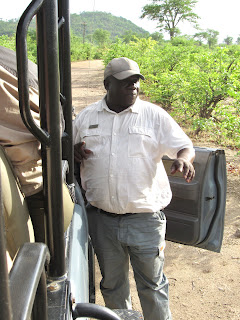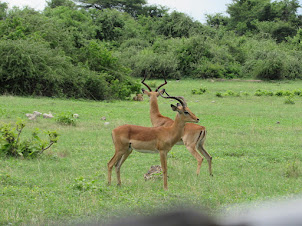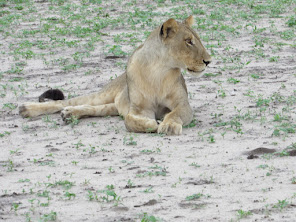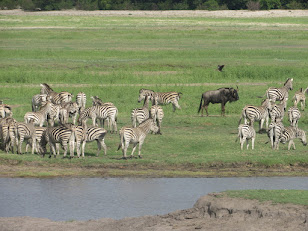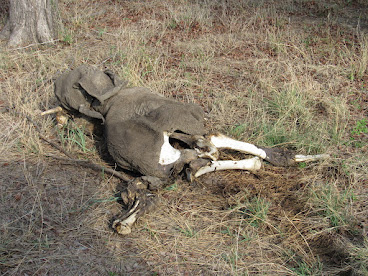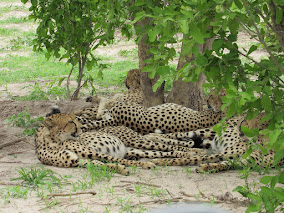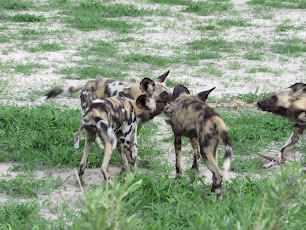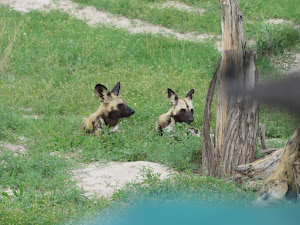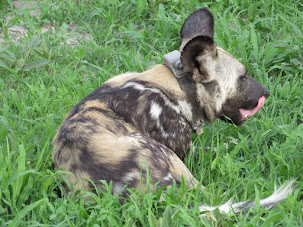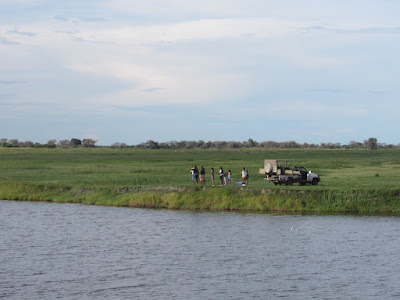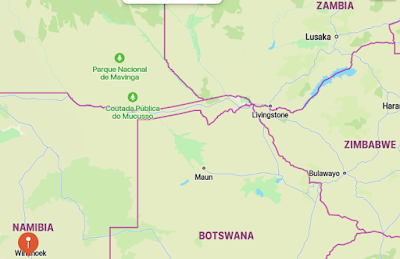If you are a tracker for a safari, you've got to know where the animals are so that you can please your guests. However, the animals don't carry a little bell to let trackers know where they are. Out in the bush, trackers learn to spot certain signs. The trackers on our game drives were excellent and very professional at what they did. We were amazed at how they found almost every animal we wanted to see.

Our wonderful trackers were patient, resourceful, and doggedly focused on finding animals for us to see--and in explaining bush life.
Godfrey (Kashawe Camp in Zimbabwe)
SP (Baobab Camp in Botswana)
Six (Toka Leya Camp in Zambia)

James (Toka Leya Camp in Zambia) and Fannah (Santawani Okavango Delta Camp)
The trackers were also excellent drivers, too, on the bumpy dirt roads--and non-roads. They were careful so that no one fell out of the jeeps, which had only an arm rest to keep people inside and a hand bar to hold. (Actually, drivers could lose their game drive license if anyone fell out of the jeep.) They drove 30-40 miles per hour until they came to a bump, a low spot, or a water puddle before they slowed down and crossed it. When they spotted an animal or something interesting on the road, they'd stop, turn their bodies around toward us, and explain what we were seeing.
Two
jeeps like this one provided our transportation in the bush for the 12 of us. There were three rows of seats with two of
us in each row. The open
sides of the jeep and the raked seating gave us a 360-degree view. The
video below gives an idea of what it was like riding in a jeep on dirt roads.
Now what remained a mystery to us was how the trackers were able to drive on these roads and spot animals or their tracks at the same time. They shared several tricks with us that they used.
First, they looked slightly above the short trees and also observed whether or not there was some sort of movement within them. Because they knew the shapes of the animals, they were able to distinguish living beings from the numerous rocks, tree stumps, or mounds on the ground. This is not easy for rookies. For example, once I excitedly reported that I saw an animal, and our trip leader, who used to be a tracker, gently told me that it was a rock.
Trackers drive the roads almost every day. They know what has gone on in various areas of the national parks where they conduct the game drives. They also know where the animals tend to hang out. Water holes, for example, are an obvious gathering spot. They also seem to have a map in their head of the park and then tell each other by radio the location of a sighting. The jeeps drive near each even though we didn't see or hear them much until there was an animal sighting.
Some animals hang out with each other. For example, impalas are plentiful and everywhere on the plains. They sometimes provide trackers with a clue as to what predators might be around.
One day we saw some impalas on high alert calling to each other in what sounded like static on a radio. This sighting was actually a little scary because a lion or some other predator may have been hungry and contemplating a meal. We thought the lives of the peaceful impalas were at risk, and a vicious kill might take place. It didn't, but we were at least witnesses of the drama of preparing for an attack.


During this time, it turned out that two young boy lions (without manes) were on opposite sides of an area near these impala. We thought they'd be out for the kill. It was a tense moment. We held our breaths waiting for something to happen. Here is a video of one of the young lions stalking the impala.
Later a dominant lion appeared, ran after the young lions, and scolded them with some big roars. The "king" was asserting his dominance--and his territory.
Things calmed down while the two young lions chilled out. The impalas then continued on their way having survived another potentially threatening situation.
Lions don't kill indiscriminately. They assess the worth of the kill before they pursue it, our tracker told us. The episode below illustrates this.
 On our last game drive we saw a pride of 13 lions setting up for a kill. One lioness (the females do the killing) took her place at the head of the pride near a termite hill (right) while the other 12 hung back and waited patiently for her signal to attack. A pride of 13 lions would have to find a kill that was sufficient to feed all of them.
On our last game drive we saw a pride of 13 lions setting up for a kill. One lioness (the females do the killing) took her place at the head of the pride near a termite hill (right) while the other 12 hung back and waited patiently for her signal to attack. A pride of 13 lions would have to find a kill that was sufficient to feed all of them.


 Wildebeest like to hang out with zebras because zebras have good hearing and
can alert them to predators.
Wildebeest like to hang out with zebras because zebras have good hearing and
can alert them to predators.
 Warthogs like to hang with zebras as well. These are among the first zebras we saw. They were on the road and then casually walked off into the bush.
Warthogs like to hang with zebras as well. These are among the first zebras we saw. They were on the road and then casually walked off into the bush.
I had taken zebras for granted as common animals in the wild that get knocked off by big cats. However, actually seeing the zebras made them intriguing, and they became one of my favorites.
 Our tracker found a parade of elephants on the move in the Okavango Delta, so he followed them. They seemed to be in a hurry with some purpose in mind. Our tracker knew the roads, and was able to follow the elephants by driving around them and heading them off before they passed.
Our tracker found a parade of elephants on the move in the Okavango Delta, so he followed them. They seemed to be in a hurry with some purpose in mind. Our tracker knew the roads, and was able to follow the elephants by driving around them and heading them off before they passed.
As the elephants walked by us, one of them gave us a lot of attitude by facing the jeep and leering at us down its huge trunk. We sat in the jeep stiffened out of fear that elephant might attack us, but the tracker remained cool and calm. He knew the elephant wouldn't attack. Actually, elephants seem to have a lot of attitude, which they express by swinging their trunks and huffing and puffing at visitors in disgust.
Here is the elephant parade on video. If I'd kept my camera on for just a little bit longer, I would have photographed the elephant that reprimanded us. The video also shows how close we were to them.
Trackers know the animals' behaviors very well, which also helps them know where to find them--and when to avoid them, if necessary. On our way back to camp one evening, we encountered a big, male elephant on the road who was having a testosterone rush and looking for a mate. He urinated on his legs, our tracker told us. The odor was so strong it hung in the air for a while. It smelled like goats. Our tracker kept a distance from the elephant until the animal eventually walked into the bush. "That was an angry elephant," said our tracker. So we saw the driving urge of a male elephant's time to mate.
Paw prints on the dirt roads is another clue that trackers use to find animals. Elephant prints (left) and lion tracks (right).
On one
afternoon's game drive, MC, our trip
leader, gave us a lesson in paw prints. He drew them in the sand
and explained their differences. The chart below illustrates the distinctions among the
animals' paw prints.
Besides paw prints, MC also showed us how dung droppings help trackers determine which animals have traversed the land and how close they are depending on the dung's "freshness".
The dung on top of the photo was an elephant's; the second came from giraffe; and the third was an impala's.
The bush reveals much about how the animals live, and the trackers shared much of that information with us and answering every question we asked them. Here are some examples.
An elephant sleep-over. Elephants like to rest their backs against a mound when they lie down to sleep. Their wrinkled skin leaves marks.
Elephant funeral. After an elephant dies, the other elephants return to the spot where it died to disperse the bones. This is done out of respect for the deceased elephant.
It seems that animals have what we might call a "culture" with norms. There is also some kind of intelligence going on that we humans tend to overlook. This was the single most important thing I learned on the safari trip.
This elephant's body was found near a water hole. That meant that the elephant had experienced drought and when it finally found water, it drank too much water and and its body couldn't handle it after the sudden intake of too much water. Drought is a deadly manifestation of climate change occurring right now. The dead body had a tremendously bad smell.
Elephants drink about 20 gallons of water per day.
Another dead elephant that drank too much water all at once. The bones are beginning to show through. Unfortunately, these water-starved elephants will not be given a proper funeral.
Elephants live for 50-60 years and they have about six sets of teeth. As they age, the next set of teeth grow weaker. That means that they cannot chew their food as efficiently. You can tell the age of the elephant from its dung, said Caspar.
This is dung from a mature elephant (left) that has digested its food efficiently. It contrasts decidedly with dung from an old elephant that is sinewy (below).
Dung from an older elephant is sinewy because its food isn't completely digested. The women use this material for baskets. Nothing goes to waste in the bush!
This "muffin" comes from a baby elephant.
The trackers sometimes just get lucky in finding animals, especially rare finds like these four male cheetahs who were in the midst of a two- to three-day siesta under a shady tree after a successful kill. Their bellies were full and fat, their eyes glazed, and their chests panting from the pressure of their lunch against their lungs.
How beautiful these animals were! Their coats were all spotted (that's what cheetah means) and their fur beautifully coiffed as though they had cleaned up after their meal before they "went to bed" under the tree. The black lines on their faces were well-defined and provided a mascara-like appearance. It reminded me of the heavily-made up Egyptian queens who may have been inspired to imitate the beauty of the animals as they attempted to show their power over the people.
Cheetahs live and hunt together. They are very fast runners clocking up to 75 MPG. They live in less populated areas because they would have to compete with other predators like lions and hyenas. Their greatest threat, however, are humans who hunt them for their fur or kill them to protect livestock or other domestic animals.
We watched this group for probably 20 minutes as the trackers moved the jeeps so we could get different views.

Among the more dangerous animals is the hippopotamus. They usually hang out in the water because their skin is so sensitive to the sun. The water relieves them. Hippos stand in the water although younger ones float since their legs cannot reach the bottom of the pond or stream.
Our first sighting of a hippo was this "young boy" heading toward a water hole in a rather hurried and purposeful way. It's hard to believe that these giant-sized animals can run!
This hippo was caught unawares as were we traveled down the road on our way to another sighting. He made a quick escape to the river for safety. These animals may be bigger than we are but they don't seek engagement or desire to pick a fight. They are really far more peaceful than I expected. That allows us to see them up close.

When danger is near, a hippo calls out to the rest in the pod. We saw this move while we were on a Zambezi River cruise in Zambia. We may have been too close to the hippos and were seen as a threat.
While we were in the Okavango Delta in Botswana, our tracker found this precious sight of a mother and baby. They were a bit of a distance from the rest of the pod. Babies are always precious no matter their size!
Painted Dogs
 photo by Meagan Gilcrist
photo by Meagan GilcristWhenever
we'd start a game drive, our tracker or trip leader would ask us what
we wanted to see--as if they had control over it. We gave them our requests anyway and hoped for the best. Meagan really wanted to
see painted dogs. It was her birthday, and low and behold, our tracker
found some dogs. Not just a few but about two dozen! We watched them for
about 20 minutes running, jumping, jostling, fighting, and then resting. Clearly, they were the most animated of all the animals we saw on the safari. And yet, they seem the most disciplined to follow a leader who would tell them which activity they should indulge themselves at the moment, which they did with all their hearts.




This was rest period as though the leader of the pack told everyone to lie down and be cool.

Crocodiles are hard to spot, but our trackers had no trouble. They look like logs in the water and a trained eye can see them. This croc was in a small river in Zambia. He had a stealthy manner about him as he swam in water camouflage either on the prowl or just moving from one place to another.

As we were cruising
the Zambezi River in Botswana, our trackers saw this huge female crocodile tending her nest.

I
certainly didn't expect to see ostriches on our safari, but there they were! And boy,
did they scatter when they saw us. I was lucky to get these
photos. Just after we saw them, our tracker got stuck in a muddy grassy area.

That's Namibia across the river from Botswana on the Caprivi Strip, said SP, our tracker. These people were fishing, probably illegally.
Caprivi Strip, long, narrow extension of Namibia, is an example of how European colonialism shaped the map of Africa. This odd strip of land that runs about 280 miles from the northeast corner of the country eastward to the Zambezi River was part of German South West Africa in 1884–1919. The strip was ceded by Britain in the Zanzibar Treaty (July 1, 1890) to give the German colony access to the Zambezi River. It was named after Leo Graf von Caprivi, German chancellor during 1890–94, according to Britannica.com.
The trackers not only found animals and talked about their behaviors, but they also pointed out plants, trees, and birds. This fire ball caught the tracker's eye, and we took some photos of it. It is a toxic plant that has been used for poison arrows and fishing spears as well as traditional medicine cures. Common names for the plant include blood lily, ball lily, fireball lily, blood flower, Katherine-wheel, oxtongue lily, poison root and powder puff lily
This termite hill started because of this tree. what you see is about one-third of the entire hill with two-thirds below ground.
This tree was sprouted from the termite hill.
 Termites
create a complex network of tunnels as they build up the hill that
always points north. Aardvarks will then dig into the hill and eat the
termites. This drawing shows the tunnel network of a termite hill.
Termites
create a complex network of tunnels as they build up the hill that
always points north. Aardvarks will then dig into the hill and eat the
termites. This drawing shows the tunnel network of a termite hill.
Source: The African BBQ Hunter series.
"Why do termite mounds point north?" See the 2:54 minute video explanation.
Sometimes pythons slither into the holes like this one that the aardvarks have dug out. We didn't see any pythons, but below are a couple photos from the Conservancy of South Florida that shows their size. The second photo shows a python that has just swallowed a deer.

I'm standing next to a 100-year-old termite hill that is about six feet tall. A staff member of Santawani Camp stands next to an older termite hill where aardvarks have dug several holes.
The landscape is covered with termite hills in the Okavango Delta in Botswana. These hills are utterly surreal!

And
speaking of insects, our trackers found a dung beetle and told us how it
reproduces. Many thanks to Jeanne Blom of Kansas City (yes, a Chiefs
fan) who captured this little mating dance in this video.
The
male gets the ball rolling by grabbing some dung and literally rolling
it into a ball with his hind legs. A female hooks up to the
ball and together they bury it in a soft spot in the soil. After the female deposits her eggs underground, they both leave the ball. Once the larvae emerge, they feed on the dung prepared by their parents.
Dung beetles play an important role in agriculture and tropical forests by improving nutrient recycling and soil structure with the dung. Seeds in the dung are consequently planted by the dung beetles.

The African baobab tree is the oldest tree with carbon-14 dating it over 1,000 years old. Known as the "Tree of Life" it is found in drier regions and stores water in its trunk that may be 30 feet in diameter. Elephants will scratch their tusks into it for water, as the photo shows. Its young leaves are edible. However, climate change is killing these valuable trees, according to britannica.com.
The tree on the left is a candelabra tree. The tree on the right is being strangled by a vine that wraps itself around it and sucks the life out of it.

There were a lot of these leaning trees in the bush (above) and a lot of dead trees (below) that created interesting structures.

 Caspar
from Kashawe Camp in Zimbabwe told us about the mopani tree. Caterpillars eat the leaves, and people fry up the caterpillars and eat them. The dish is called "mopani worms" (dark brown and elongated), which are
high in protein, taste good, and are considered a delicacy. A few of my fellow travelers tried them. I now wish I had.
Caspar
from Kashawe Camp in Zimbabwe told us about the mopani tree. Caterpillars eat the leaves, and people fry up the caterpillars and eat them. The dish is called "mopani worms" (dark brown and elongated), which are
high in protein, taste good, and are considered a delicacy. A few of my fellow travelers tried them. I now wish I had.

Sometimes, things go wrong, like the battery might die or the jeep gets stuck in the mud. Because the guides are all connected by radio, a simple call for help is quick and effective. And, they know what to do to fix the problem.
One day while we were on the road, the jeep just clonked out. A grinding of the engine soon revealed that the battery was the problem. Our guide called his partner guide and within five minutes the other jeep pulled our jeep with a chain, which allowed the jeep to re-start. However, it took two more tries before our jeep could go on its own. Once we returned to camp, our driver/guide had the battery checked and changed immediately. This was a good example of the teamwork the driver/guides use to keep everyone safe should any emergencies occur.
In another instance, we were off road in one of the parks and the driver/guide misjudged the terrain. He thought he could drive through this field of grass but it had a lot more water in it than he expected. We got stuck in the mud, but were soon pulled out thanks to a chain pull by our partner jeep.
We were grateful to our game driver/trackers. They made our safari experience inspiring, interesting, and informative. MC, our trip leader poses with them. (Thanks Meagan for these photos!)

Resources
https://a-z-animals.com/blog/what-is-a-group-of-cheetahs-called/
https://en.wikipedia.org/wiki/Giraffe
https://a-z-animals.com/blog/male-vs-female-giraffes-key-differences/
https://www.britannica.com/place/Caprivi-Strip
https://en.wikipedia.org/wiki/Dung_beetle
https://www.britannica.com/plant/baobab-tree-genus
https://afktravel.com/93224/10-things-you-didnt-know-about-african-acacia-trees/

